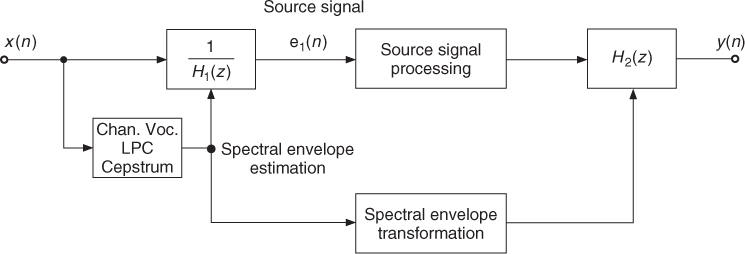8.2 Source-filter Separation
Digital audio effects based on source-filter processing extract the spectral envelope and the source (excitation) signal from an input signal, as shown in Figure 8.2. The input signal is whitened by the filter 1/H1(z), which is derived from the spectral envelope of the input signal. In signal-processing terms, the spectral envelope is given by the magnitude response |H1(f)| or its logarithm log|H1(f)| in dB. This leads to extraction of the source signal e1(n) which can be further processed, for example, by time-stretching or pitch-shifting algorithms. The processed source signal is then finally filtered by H2(z). This filter is derived from the modified spectral envelope of the input signal or another source signal.
Figure 8.2 Spectrum estimation (Channel vocoder, Linear Predictive Coding or Cepstrum) and source-signal extraction for individual processing.

8.2.1 Channel Vocoder
If we filter a sound with a bank of bandpass filters and calculate the RMS value for each bandpass signal, we can obtain an estimation of the spectral envelope (see Figure 8.3). The parameters of the filters for each channel will of course affect the precision of the measurement, as well as the delay between the sound input and the spectral calculation. The RMS calculation parameters are also a compromise between good definition and an acceptable delay and trail effect. The ...
Get DAFX: Digital Audio Effects, Second Edition now with the O’Reilly learning platform.
O’Reilly members experience books, live events, courses curated by job role, and more from O’Reilly and nearly 200 top publishers.

